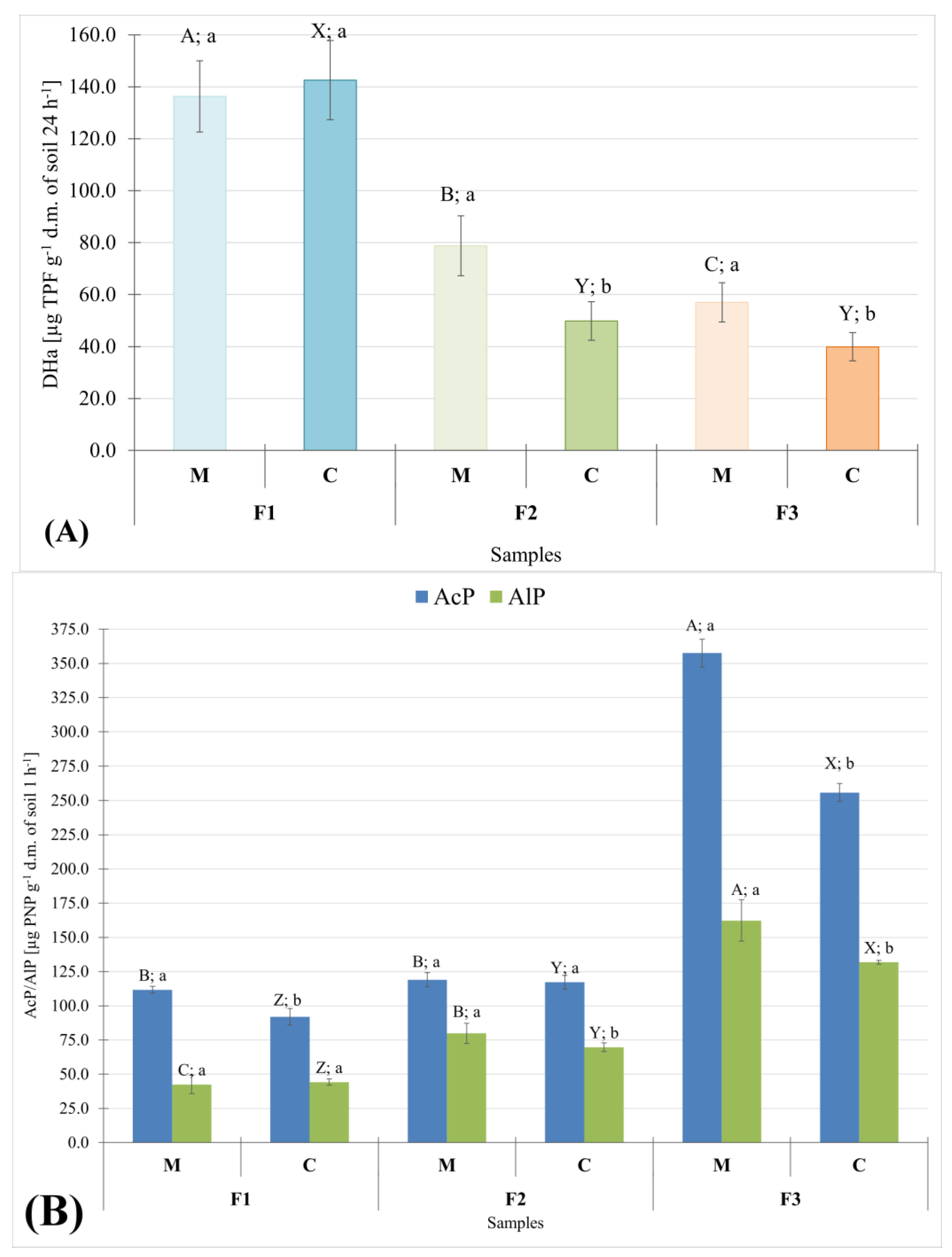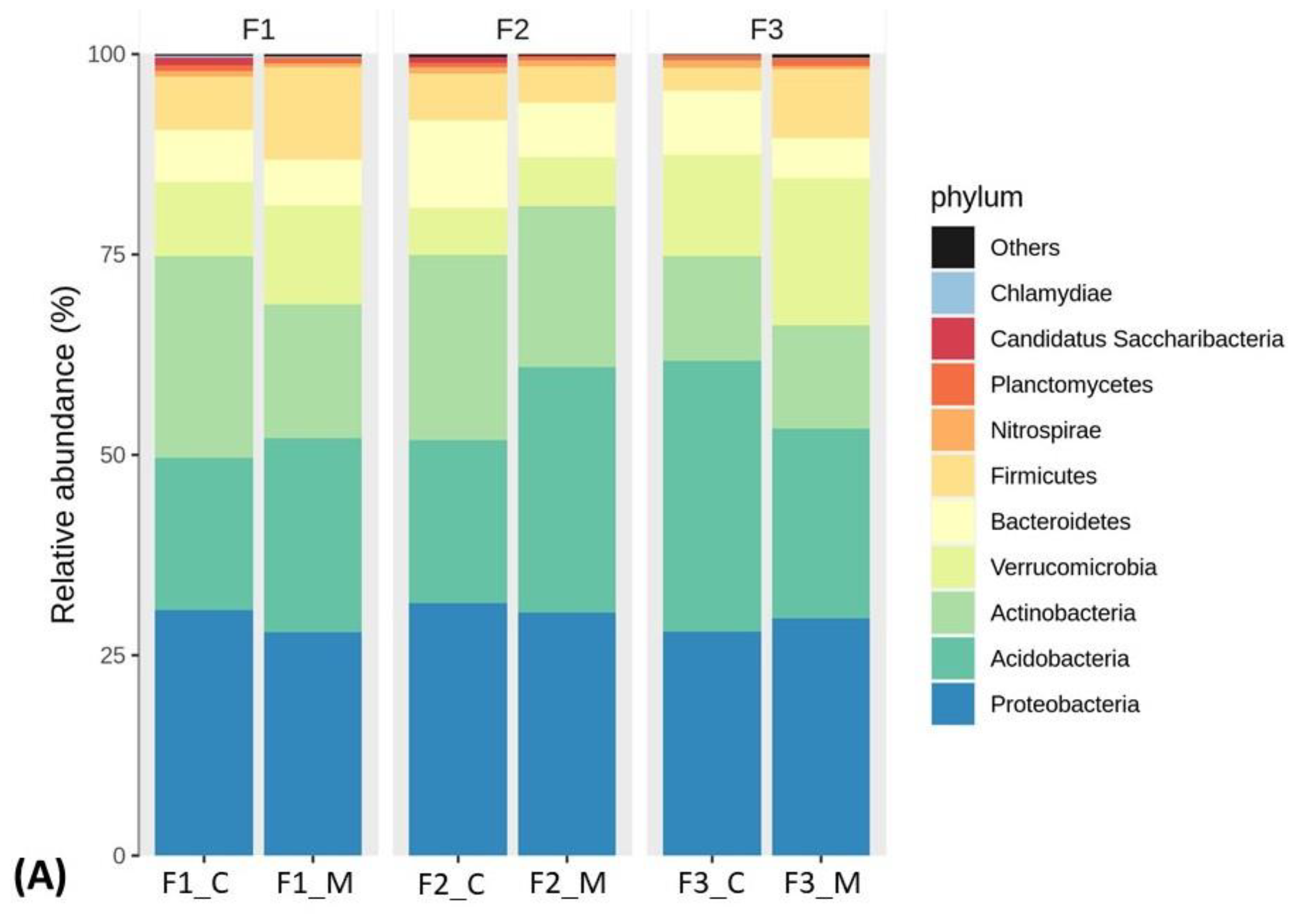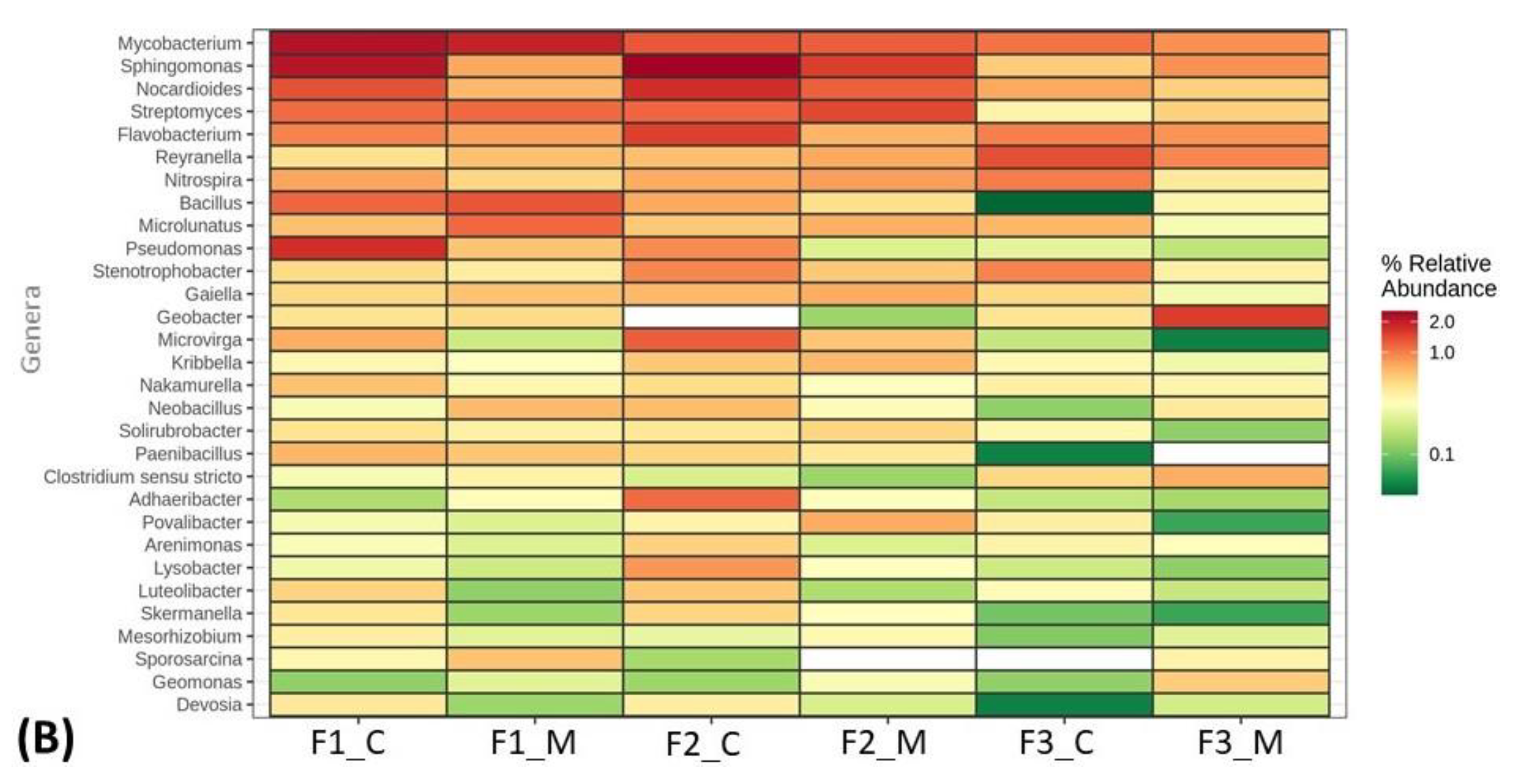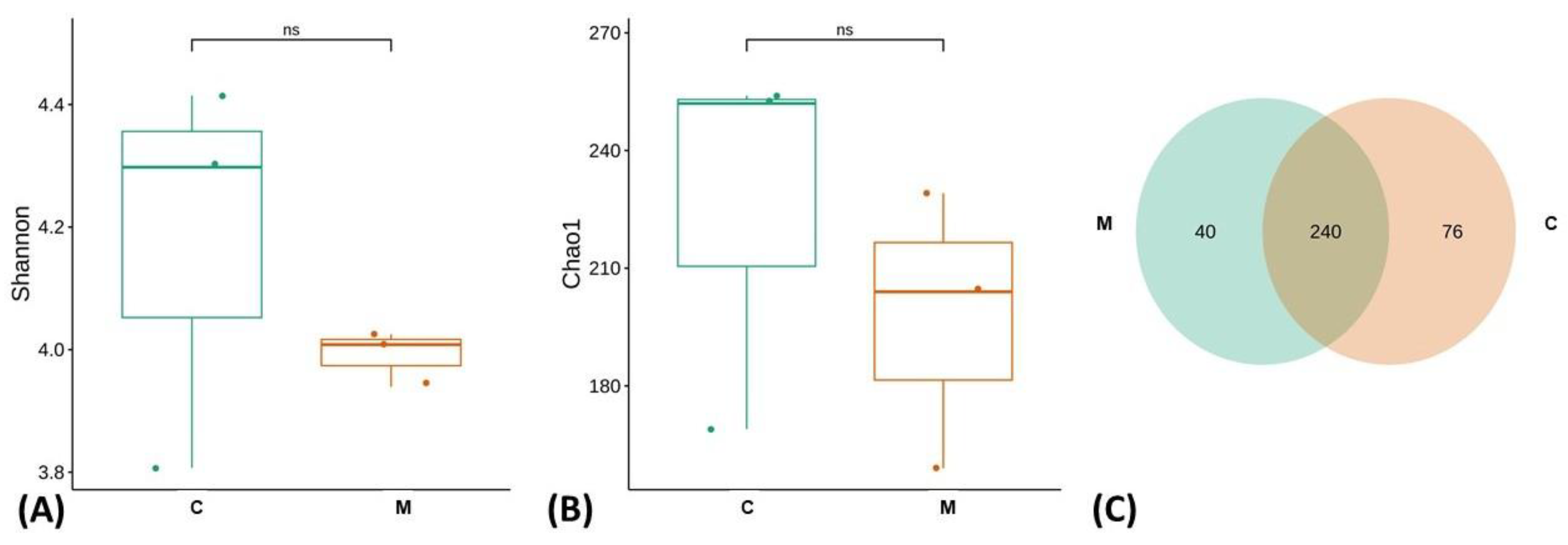The Influence of Human Agricultural Activities on the Quality of Selected Fluvisols from the Vistula River Valley, Poland—Preliminary Research
Abstract
1. Introduction
2. Materials and Methods
2.1. Soil Location and Sampling
2.2. Soil Physicochemical Parameters
2.3. Soil Biological Parameters
2.4. Soil Microbiome Analysis
2.5. Data Analysis and Visualisation
3. Results and Discussion
3.1. Soil Physicochemical Properties
3.2. Biological Activity in Fluvisols
3.3. Microbiome Diversity of Fluvisols
- F1_M: Proteobacteria > Acidobateria > Actinobacteria > Verrucomicrobia;
- F1_C: Proteobacteria > Actinobacteria > Acidobacteria > Verrucomicrobia;
- F2_M: Acidobacteria > Proteobacteria > Actinobacteria > Bacteroidetes;
- F2_C: Proteobacteria > Actinobacteria > Acidobacteria > Bacteroidetes;
- F3_M: Proteobacteria > Acidobateria > Verrucomicrobia > Actinobacteria;
- F3_C: Acidobacteria > Proteobacteria > Actinobacteria > Verrucomicrobia.
- F1_M: Mycobacterium > Bacillus > Streptomyces > Microlunastus;
- F1_C: Mycobacterium > Sphingomonas > Pseudomonas > Nocardioides;
- F2_M: Sphingomonas > Streptomyces > Mycobacterium > Nocardioides;
- F2_C: Sphingomonas > Nocardioides > Flavobacterium > Mycobacterium;
- F3_M: Geobacter > Sphingomonas > Flavobacterium > Mycobacterium;
- F3_C: Sphingomonas > Reyranella > Mycobacterium > Flavobacterium.
4. Conclusions
Supplementary Materials
Author Contributions
Funding
Data Availability Statement
Acknowledgments
Conflicts of Interest
References
- Lehmann, J.; Bossio, D.A.; Kögel-Knabner, I.; Rillig, M.C. The Concept and Future Prospects of Soil Health. Nat. Rev. Earth Environ. 2020, 1, 544–553. [Google Scholar] [CrossRef]
- Zwetsloot, M.J.; van Leeuwen, J.; Hemerik, L.; Martens, H.; Simó Josa, I.; Van de Broek, M.; Debeljak, M.; Rutgers, M.; Sandén, T.; Wall, D.P.; et al. Soil Multifunctionality: Synergies and Trade-Offs across European Climatic Zones and Land Uses. Eur. J. Soil Sci. 2021, 72, 1640–1654. [Google Scholar] [CrossRef]
- Delgado-Baquerizo, M.; Reich, P.B.; Trivedi, C.; Eldridge, D.J.; Abades, S.; Alfaro, F.D.; Bastida, F.; Berhe, A.A.; Cutler, N.A.; Gallardo, A.; et al. Multiple Elements of Soil Biodiversity Drive Ecosystem Functions across Biomes. Nat. Ecol. Evol. 2020, 4, 210–220. [Google Scholar] [CrossRef]
- Girvan, M.S.; Bullimore, J.; Pretty, J.N.; Osborn, A.M.; Ball, A.S. Soil Type Is the Primary Determinant of the Composition of the Total and Active Bacterial Communities in Arable Soils Soil Type Is the Primary Determinant of the Composition of the Total and Active Bacterial Communities in Arable Soils. Soil Biol. Biochem. 2014, 8, 1–8. [Google Scholar] [CrossRef]
- de Gannes, V.; Eudoxie, G.; Bekele, I.; Hickey, W.J. Relations of Microbiome Characteristics to Edaphic Properties of Tropical Soils from Trinidad. Front. Microbiol. 2015, 6, 01045. [Google Scholar] [CrossRef] [PubMed]
- Suzuki, C.; Kunito, T.; Aono, T.; Liu, C.-T.; Oyaizu, H. Microbial Indices of Soil Fertility. J. Appl. Microbiol. 2005, 98, 1062–1074. [Google Scholar] [CrossRef]
- Gałązka, A.; Łyszcz, M.; Abramczyk, B.; Furtak, K.; Grządziel, J.; Czaban, J.; Pikulicka, A. Biodiversity of Soil Environment—Overview of Parameters and Methods in Soil Biodiversity Analyses; Monografie i Rozprawy naukowe IUNG-PIB: Puławy, Poland, 2016; ISBN 978-83-7562-246-1. [Google Scholar]
- Özcan, H. Fluvisols; Springer: Berlin/Heidelberg, Germany, 2018. [Google Scholar]
- Mays, L.W. Water Technology in Ancient Egypt. In Ancient Water Technologies; Springer: Dordrecht, The Netherlands, 2010; pp. 53–65. ISBN 9789048186310. [Google Scholar]
- Morozova, G.S. A Review of Holocene Avulsions of the Tigris and Euphrates Rivers and Possible Effects on the Evolution of Civilizations in Lower Mesopotamia. Geoarchaeology 2005, 20, 401–423. [Google Scholar] [CrossRef]
- Li, Y.; Jiang, Z.; Chen, Z.; Yu, Y.; Lan, F.; Shan, Z.; Sun, Y.; Liu, P.; Tang, X.; Rodrigo-Comino, J. Anthropogenic Disturbances and Precipitation Affect Karst Sediment Discharge in the Nandong Underground River System in Yunnan, Southwest China. Sustainability 2020, 12, 3006. [Google Scholar] [CrossRef]
- FAO. World Reference Base for Soil Resources 2006; FAO: Rome, Italy, 2006. [Google Scholar]
- Anjos, L.; Gaistardo, C.; Deckers, J.; Dondeyne, S.; Eberhardt, E.; Gerasimova, M.; Harms, B.; Jones, A.; Krasilnikov, P.; Reinsch, T.; et al. World Reference Base for Soil Resources 2014. In International Soil Classification System for Naming Soils and Creating Legends for Soil Maps, JRC91947 ed.; Schad, P., Van Huyssteen, C., Micheli, E., Eds.; FAO: Rome, Italy, 2014; ISBN 9789251083697. [Google Scholar]
- Banach-Szott, M.; Kondratowicz-Maciejewska, K.; Kobierski, M. Humic Substances in Fluvisols of the Lower Vistula Floodplain, North Poland. Environ. Sci. Pollut. Res. 2018, 25, 23992–24002. [Google Scholar] [CrossRef]
- Cyberski, J.; Grześ, M.; Gutry-Korycka, M.; Nachlik, E.; Kundzewicz, Z.W. History of Floods on the River Vistula. Hydrol. Sci. J. 2006, 51, 799–817. [Google Scholar] [CrossRef]
- Kobierski, M.; Banach-Szott, M. Organic Matter in Riverbank Sediments and Fluvisols from the Flood Zones of Lower Vistula River. Agronomy 2022, 12, 536. [Google Scholar] [CrossRef]
- Orzechowski, M.; Smólczyński, S.; Kalisz, B.; Sowiński, P. Origin, Properties and Agricultural Value of Alluvial Soils in the Vistula and Pasłęka Deltas, North Poland. Soil Sci. Annu. 2022, 73, 157350. [Google Scholar] [CrossRef]
- Rodrigo-Comino, J.; Keshavarzi, A.; Senciales-González, J.M. Evaluating Soil Quality Status of Fluvisols at the Regional Scale: A Multidisciplinary Approach Crossing Multiple Variables. River Res. Appl. 2023, 39, 1367–1381. [Google Scholar] [CrossRef]
- Shi, M.; Wu, H.; Fan, X.; Jia, H.; Dong, T.; He, P.; Baqa, M.F.; Jiang, P. Trade-Offs and Synergies of Multiple Ecosystem Services for Different Land Use Scenarios in the Yili River Valley, China. Sustainability 2021, 13, 1577. [Google Scholar] [CrossRef]
- Shi, F.; Liu, S.; Sun, Y.; An, Y.; Zhao, S.; Liu, Y.; Li, M. Ecological Network Construction of the Heterogeneous Agro-Pastoral Areas in the Upper Yellow River Basin. Agric. Ecosyst. Environ. 2020, 302, 107069. [Google Scholar] [CrossRef]
- Furtak, K.; Grządziel, J.; Gałązka, A.; Niedźwiecki, J. Prevalence of Unclassified Bacteria in the Soil Bacterial Community from Floodplain Meadows (Fluvisols) under Simulated Flood Conditions Revealed by a Metataxonomic Approachss. Catena 2020, 188, 104448. [Google Scholar] [CrossRef]
- Silvana, V.M.; Carlos, F.J.; Lucía, A.C.; Natalia, A.; Marta, C. Colonization Dynamics of Arbuscular Mycorrhizal Fungi (AMF) in Ilex Paraguariensis Crops: Seasonality and Influence of Management Practices. J. King Saud. Univ. Sci. 2020, 32, 183–188. [Google Scholar] [CrossRef]
- Sánchez-Rodríguez, A.R.; Nie, C.; Hill, P.W.; Chadwick, D.R.; Jones, D.L. Extreme Flood Events at Higher Temperatures Exacerbate the Loss of Soil Functionality and Trace Gas Emissions in Grassland. Soil Biol. Biochem. 2019, 130, 227–236. [Google Scholar] [CrossRef]
- Mhuantong, W.; Wongwilaiwalin, S.; Laothanachareon, T.; Eurwilaichitr, L.; Tangphatsornruang, S.; Boonchayaanant, B.; Limpiyakorn, T.; Pattaragulwanit, K.; Punmatharith, T.; McEvoy, J.; et al. Survey of Microbial Diversity in Flood Areas during Thailand 2011 Flood Crisis Using High-Throughput Tagged Amplicon Pyrosequencing. PLoS ONE 2015, 10, e0128043. [Google Scholar] [CrossRef]
- Ralph, T.J.; Kobayashi, T. Impact of Inundation on Soil Microbiology. Microbiol. Aust. 2023, 44, 181–184. [Google Scholar] [CrossRef]
- Ding, L.; Zhou, J.; Li, Q.; Tang, J.; Chen, X. Effects of Land-Use Type and Flooding on the Soil Microbial Community and Functional Genes in Reservoir Riparian Zones. Microb. Ecol. 2022, 83, 393–407. [Google Scholar] [CrossRef]
- Climate date.org. Climate Date. Available online: https://en.climate-data.org/ (accessed on 11 January 2019).
- Litynski, T.; Jurkowska, H.; Gorlach, E. Chemical and Agricultural Analysis; Wydawnictwo Naukowe PWN: Warszawa, Poland, 1976. [Google Scholar]
- Ostrowska, A.; Gawliński, S.; Szczubiałka, Z. Methods of Analysis and Assessment of Soil and Plant Properties: Catalogue; Dział Wydawnictw IOŚ: Warszawa, Poland, 1991. [Google Scholar]
- DIN/ISO 13878:1998; Soil Quality—Determination of Total Nitrogen Content by Dry Combustion (“Elemental Analysis”). American National Standards Institute: Washington, DC, USA, 2007.
- ISO 13395:1996; Water Quality—Determination of Nitrite Nitrogen and Nitrate Nitrogen and the Sum of Both by Flow Analysis (CFA and FIA) and Spectrometric Detection. American National Standards Institute: Washington, DC, USA, 1996.
- Casida, L.; Klein, D.; Santoro, T. Soil Dehydrogenase Activity. Soil Sci. 1964, 98, 371–376. [Google Scholar] [CrossRef]
- Tabatabai, M.A. Soil Enzymes. In Methods of Soil Analysis; Page, A.L., Miller, R.H., Keeney, D.R., Eds.; American Society of Agronomy Inc.; Soil Science Society of America Inc.: Madison, WI, USA, 1982; pp. 903–948. [Google Scholar]
- PN-ISO 1038-6:1998; Soil Quality—Determination of Soil Microbial Biomass—Part 2: Fumigation-Extraction Method. American National Standards Institute: Washington, DC, USA, 2007.
- Weber, K.P.; Legge, R.L. One-Dimensional Metric for Tracking Bacterial Community Divergence Using Sole Carbon Source Utilization Patterns. J. Microbiol. Methods 2009, 79, 55–61. [Google Scholar] [CrossRef] [PubMed]
- Insam, H.; Goberna, M. Use of Biolog® for the Community Level Physiological Profiling (CLPP) of Environmental Samples. In Molecular Microbial Ecology Manual; Kowalchuk, G.A., de Brujin, F.J., Head, I.M., Akkermans, A.D., van Elsas, J.D., Eds.; Kluwer Academic Publishers: Dordrecht, The Netherlands, 2004; pp. 853–860. [Google Scholar]
- Klindworth, A.; Pruesse, E.; Schweer, T.; Peplies, J.; Quast, C.; Horn, M.; Glöckner, F.O. Evaluation of General 16S Ribosomal RNA Gene PCR Primers for Classical and Next-Generation Sequencing-Based Diversity Studies. Nucleic Acids Res. 2013, 41, e1. [Google Scholar] [CrossRef] [PubMed]
- Garland, J.L.; Mills, A.L. Classification and Characterization of Heterotrophic Microbial Communities on the Basis of Patterns of Community-Level Sole-Carbon-Source Utilization. Appl. Environ. Microbiol. 1991, 57, 2351–2359. [Google Scholar] [CrossRef]
- Furtak, K.; Grządziel, J.; Gałązka, A.; Niedźwiecki, J. Analysis of Soil Properties, Bacterial Community Composition, and Metabolic Diversity in Fluvisols of a Floodplain Area. Sustainability 2019, 11, 3929. [Google Scholar] [CrossRef]
- Frąc, M.; Oszust, K.; Lipiec, J. Community Level Physiological Profiles (CLPP), Characterization and Microbial Activity of Soil Amended with Dairy Sewage Sludge. Sensors 2012, 12, 3253. [Google Scholar] [CrossRef]
- Callahan, B.J.; McMurdie, P.J.; Rosen, M.J.; Han, A.W.; Johnson, A.J.A.; Holmes, S.P. DADA2: High-Resolution Sample Inference from Illumina Amplicon Data. Nat. Methods 2016, 13, 581–583. [Google Scholar] [CrossRef] [PubMed]
- R Core Team. R: A Language and Environment for Statistical Computing. In R Foundation for Statistical Computing; R Core Team: Vienna, Austria, 2016. [Google Scholar]
- Wang, Q.; Garrity, G.M.; Tiedje, J.M.; Cole, J.R. Naive Bayesian Classifier for Rapid Assignment of RRNA Sequences into the New Bacterial Taxonomy. Appl. Environ. Microbiol. 2007, 73, 5261–5267. [Google Scholar] [CrossRef]
- Murali, A.; Bhargava, A.; Wright, E.S. IDTAXA: A Novel Approach for Accurate Taxonomic Classification of Microbiome Sequences. Microbiome 2018, 6, 140. [Google Scholar] [CrossRef]
- McMurdie, P.J.; Holmes, S. Phyloseq: An R Package for Reproducible Interactive Analysis and Graphics of Microbiome Census Data. PLoS ONE 2013, 8, e61217. [Google Scholar] [CrossRef]
- Liu, C.; Cui, Y.; Li, X.; Yao, M. Microeco: An R Package for Data Mining in Microbial Community Ecology. FEMS Microbiol. Ecol. 2021, 97, 255. [Google Scholar] [CrossRef]
- Šimanský, V. Can Soil Properties of Fluvisols Be Influenced by River Flow Gradient? Acta Fytotech. Zootech. 2018, 21, 63–76. [Google Scholar] [CrossRef]
- Kobierski, M. Evaluation of the Content of Heavy Metals in Fluvisols of Floodplain Area Depending on the Type of Land Use. J. Ecol. Eng. 2015, 16, 23–31. [Google Scholar] [CrossRef] [PubMed][Green Version]
- Journal of Laws 2002 No 165 Item 1359 Dziennik Ustaw 2002. Rozporza˛dzenie Ministra S´rodowiska, Z˙ Elichowski, S. z Dn. 09.09.2002 w Sprawie Standardów Jakos´ci Gleby Oraz Jakos´ci Ziemi. Dz. U. 2002, Nr 165, Poz. 1359. Available online: http://prawo.sejm.gov.pl/isap.nsf/DocDetails.xsp?%20id=WDU200216%2051359 (accessed on 10 December 2023).
- Sowiński, P.; Glińska-Lewczuk, K.; Kalisz, B.; Astel, A. Distribution of heavy metals in soils in a postglacial river valley—A geochemical landscape approach. Environ. Eng. Manag. J. (EEMJ) 2016, 15, 1323–1335. [Google Scholar] [CrossRef]
- Grządziel, J.; Gałązka, A.; Gałazka, A. Microplot Long-Term Experiment Reveals Strong Soil Type Influence on Bacteria Composition and Its Functional Diversity. Appl. Soil Ecol. 2018, 124, 117–123. [Google Scholar] [CrossRef]
- Zamulina, I.V.; Gorovtsov, A.V.; Minkina, T.M.; Mandzhieva, S.S.; Burachevskaya, M.V.; Bauer, T.V. Soil Organic Matter and Biological Activity under Long-Term Contamination with Copper. Environ. Geochem. Health 2022, 44, 387–398. [Google Scholar] [CrossRef] [PubMed]
- Furtak, K.; Gałązka, A. Enzymatic Activity as a Popular Parameter Used to Determine the Quality of the Soil Environment. Pol. J. Agron. 2019, 37, 22–30. [Google Scholar] [CrossRef]
- Gajda, A.M.; Czyż, E.A.; Klimkowicz-Pawlas, A. Effects of Different Tillage Intensities on Physicochemical and Microbial Properties of a Eutric Fluvisol Soil. Agronomy 2021, 11, 1497. [Google Scholar] [CrossRef]
- Liu, C.; Zhao, X.; Lin, Q.; Li, G. Decrease in Diversity and Shift in Composition of the Soil Bacterial Community Were Closely Related to High Available Phosphorus in Agricultural Fluvisols of North China. Acta Agric. Scand. B Soil Plant Sci. 2019, 69, 618–630. [Google Scholar] [CrossRef]
- Delgado-Baquerizo, M.; Oliverio, A.M.; Brewer, T.E.; Benavent-González, A.; Eldridge, D.J.; Bardgett, R.D.; Maestre, F.T.; Singh, B.K.; Fierer, N. A Global Atlas of the Dominant Bacteria Found in Soil. Science 2018, 359, 320–325. [Google Scholar] [CrossRef]
- Kniazeva, A.V.; Lysak, L.V.; Manucharova, N.A.; Lapygina, E.V.; Aleksandrova, A.V. Abundance and Taxonomic Diversity of Prokaryotes in Fluvisol and Associated Substrates (Vietnam, Pu Hoat Reserve). Eurasian Soil Sci. 2022, 55, 1460–1469. [Google Scholar] [CrossRef]
- Praeg, N.; Seeber, J.; Leitinger, G.; Tasser, E.; Newesely, C.; Tappeiner, U.; Illmer, P. The Role of Land Management and Elevation in Shaping Soil Microbial Communities: Insights from the Central European Alps. Soil Biol. Biochem. 2020, 150, 107951. [Google Scholar] [CrossRef]
- Yu, X.Y.; Zhu, Y.J.; Wang, B.; Liu, D.; Bai, H.; Jin, L.; Wang, B.T.; Ruan, H.H.; Mao, L.; Jin, F.J.; et al. Effects of Nitrogen Addition on Rhizospheric Soil Microbial Communities of Poplar Plantations at Different Ages. For. Ecol. Manag. 2021, 494, 119328. [Google Scholar] [CrossRef]
- Lan, J.; Wang, S.; Wang, J.; Qi, X.; Long, Q.; Huang, M. The Shift of Soil Bacterial Community After Afforestation Influence Soil Organic Carbon and Aggregate Stability in Karst Region. Front. Microbiol. 2022, 13, 901126. [Google Scholar] [CrossRef]
- Farag, I.F.; Youssef, N.H.; Elshahed, M.S. Global Distribution Patterns and Pangenomic Diversity of the Candidate Phylum “Latescibacteria” (WS3). Appl. Environ. Microbiol. 2017, 83, e00521-17. [Google Scholar] [CrossRef]
- Choudhary, S.; Mishra, B.K.; Singh, R.; Sharma, R. Bacterial Diversity and Bio-Chemical Properties in the Rhizosphere Soils of Cumin and Coriander. Trop. Ecol. 2021, 62, 368–376. [Google Scholar] [CrossRef]
- Yang, Z.; Xu, Y.; Li, H.; Li, S.; Wang, X.; Chai, H. Difference of Bacterial Community Structure in the Meadow, Maize, and Continuous Cropped Alfalfa in Northeast China. Front. Microbiol. 2022, 13, 794848. [Google Scholar] [CrossRef] [PubMed]
- Wang, H.; Liu, S.; Kuzyakov, Y.; Zhan, P.; Wang, Q.; Hettenhausen, C.; Xiao, D.; Qi, J.; Zhang, Z. Differentiating Microbial Taxonomic and Functional Responses to Physical Disturbance in Bulk and Rhizosphere Soils. Land. Degrad. Dev. 2020, 31, 2858–2871. [Google Scholar] [CrossRef]
- Asaf, S.; Numan, M.; Khan, A.L.; Al-Harrasi, A. Sphingomonas: From Diversity and Genomics to Functional Role in Environmental Remediation and Plant Growth. Crit. Rev. Biotechnol. 2020, 40, 138–152. [Google Scholar] [CrossRef] [PubMed]
- Zhang, X.; Hu, Z.; Pan, H.; Bai, Y.; Hu, Y.; Jin, S. Effects of Rare Earth Elements on Bacteria in Rhizosphere, Root, Phyllosphere and Leaf of Soil–Rice Ecosystem. Sci. Rep. 2022, 12, 2089. [Google Scholar] [CrossRef] [PubMed]
- Rachmania, M.K.; Ningsih, F.; Sari, D.C.A.F.; Sakai, Y.; Yabe, S.; Eshananda, Y.; Yokota, A.; Sjamsuridzal, W. Identification and Screening of Enzymatic Abilities of Ktedonobacteria from Forest Soil of Cisolok Geothermal Area, Indonesia. Biodiversitas 2022, 23, 4686–4695. [Google Scholar] [CrossRef]
- Jurelevicius, D.; da Pereira, R.S.; da Mota, F.F.; Cury, J.C.; de Oliveira, I.C.; Rosado, A.S.; Mason, O.U.; Jansson, J.K.; Seldin, L. Metagenomic Analysis of Microbial Communities across a Transect from Low to Highly Hydrocarbon-contaminated Soils in King George Island, Maritime Antarctica. Geobiology 2022, 20, 98–111. [Google Scholar] [CrossRef]
- Sakineh, A.; Ayme, S.; Akram, S.; Naser, S. Streptomyces Strains Modulate Dynamics of Soil Bacterial Communities and Their Efficacy in Disease Suppression Caused by Phytophthora Capsici. Sci. Rep. 2021, 11, 9317. [Google Scholar] [CrossRef]
- Villamil, M.B.; Kim, N.; Riggins, C.W.; Zabaloy, M.C.; Allegrini, M.; Rodríguez-Zas, S.L. Microbial Signatures in Fertile Soils Under Long-Term N Management. Front. Soil Sci. 2021, 1, 765901. [Google Scholar] [CrossRef]
- Corretto, E.; Antonielli, L.; Sessitsch, A.; Höfer, C.; Puschenreiter, M.; Widhalm, S.; Swarnalakshmi, K.; Brader, G. Comparative Genomics of Microbacterium Species to Reveal Diversity, Potential for Secondary Metabolites and Heavy Metal Resistance. Front. Microbiol. 2020, 11, 531937. [Google Scholar] [CrossRef]
- García-López, M.; Meier-Kolthoff, J.P.; Tindall, B.J.; Gronow, S.; Woyke, T.; Kyrpides, N.C.; Hahnke, R.L.; Göker, M. Analysis of 1000 Type-Strain Genomes Improves Taxonomic Classification of Bacteroidetes. Front. Microbiol. 2019, 10, 415297. [Google Scholar] [CrossRef]
- Cao, Y.; Zhang, J.; Du, P.; Ji, J.; Zhang, X.; Xu, J.; Ma, C.; Liang, B. Melatonin Alleviates Cadmium Toxicity by Regulating Root Endophytic Bacteria Community Structure and Metabolite Composition in Apple. Tree Physiol. 2024, 44, tpae009. [Google Scholar] [CrossRef]
- DiLegge, M.J.; Manter, D.K.; Vivanco, J.M. Soil Microbiome Disruption Reveals Specific and General Plant-Bacterial Relationships in Three Agroecosystem Soils. PLoS ONE 2022, 17, e0277529. [Google Scholar] [CrossRef]
- Wang, Y.; Sun, Q.; Liu, J.; Wang, L.; Wu, X.; Zhao, Z.; Wang, N.; Gao, Z. Suaeda Salsa Root-Associated Microorganisms Could Effectively Improve Maize Growth and Resistance under Salt Stress. Microbiol. Spectr. 2022, 10, e0134922. [Google Scholar] [CrossRef] [PubMed]
- Fan, K.; Feng, Q.; Li, K.; Lin, J.; Wang, W.; Cao, Y.; Gai, H.; Song, H.; Huang, T.; Zhu, Q.; et al. The Metabolism of Pyrene by a Novel Altererythrobacter sp. with in-situ Co-Substrates: A Mechanistic Analysis Based on Pathway, Genomics, and Enzyme Activity. Chemosphere 2022, 307, 135784. [Google Scholar] [CrossRef] [PubMed]
- Li, H.P.; Yao, D.; Shao, K.Z.; Han, Q.Q.; Gou, J.Y.; Zhao, Q.; Zhang, J.L. Altererythrobacter Rhizovicinus sp. Nov., Isolated from Rhizosphere Soil of Haloxylon Ammodendron. Int. J. Syst. Evol. Microbiol. 2020, 70, 680–686. [Google Scholar] [CrossRef] [PubMed]
- Fifer, J.E.; Bui, V.; Berg, J.T.; Kriefall, N.; Klepac, C.; Bentlage, B.; Davies, S.W. Microbiome Structuring Within a Coral Colony and Along a Sedimentation Gradient. Front. Mar. Sci. 2022, 8, 805202. [Google Scholar] [CrossRef]
- Tsiafouli, M.A.; Thébault, E.; Sgardelis, S.P.; de Ruiter, P.C.; van der Putten, W.H.; Birkhofer, K.; Hemerik, L.; de Vries, F.T.; Bardgett, R.D.; Brady, M.V.; et al. Intensive Agriculture Reduces Soil Biodiversity across Europe. Glob. Change Biol. 2015, 21, 973–985. [Google Scholar] [CrossRef]
- Wicaksono, W.A.; Buko, A.; Kusstatscher, P.; Cernava, T.; Sinkkonen, A.; Laitinen, O.H.; Virtanen, S.M.; Hyöty, H.; Berg, G. Impact of Cultivation and Origin on the Fruit Microbiome of Apples and Blueberries and Implications for the Exposome. Microb. Ecol. 2023, 86, 973–984. [Google Scholar] [CrossRef]
- Liu, W.; Jiang, L.; Yang, S.; Wang, Z.; Tian, R.; Peng, Z.; Chen, Y.; Zhang, X.; Kuang, J.; Ling, N.; et al. Critical Transition of Soil Bacterial Diversity and Composition Triggered by Nitrogen Enrichment. Ecology 2020, 101, e03053. [Google Scholar] [CrossRef]
- Salleh, N.; Goh, K.K.T.; Sims, I.M.; Bell, T.J.; Huffman, L.M.; Weeks, M.; Matia-Merino, L. Characterization of Anthocyanin-Bound Pectin-Rich Fraction Extracted from New Zealand Blackcurrant (Ribes Nigrum) Juice. ACS Food Sci. Technol. 2021, 1, 1130–1142. [Google Scholar] [CrossRef]
- Widdig, M.; Heintz-Buschart, A.; Schleuss, P.M.; Guhr, A.; Borer, E.T.; Seabloom, E.W.; Spohn, M. Effects of Nitrogen and Phosphorus Addition on Microbial Community Composition and Element Cycling in a Grassland Soil. Soil Biol. Biochem. 2020, 151, 108041. [Google Scholar] [CrossRef]
- Wertz, S.; Degrange, V.; Prosser, J.I.; Poly, F.; Commeaux, C.; Guillaumaud, N.; Le Roux, X. Decline of Soil Microbial Diversity Does Not Influence the Resistance and Resilience of Key Soil Microbial Functional Groups Following a Model Disturbance. Environ. Microbiol. 2007, 9, 2211–2219. [Google Scholar] [CrossRef] [PubMed]





| Abbreviation | Soil | GPS Coordinates | Variants |
|---|---|---|---|
| F1_M | Light Fluvisols | 51°27′35.9″ N 21°52′07.8″ E | meadow |
| F1_C | cultivation | ||
| F2_M | Medium Fluvisols | 51°27′44.9″ N 21°52′14.1″ E | meadow |
| F2_C | cultivation | ||
| F3_M | Heavy Fluvisols | 51°27′37.2″ N 21°52′08.6″ E | meadow |
| F3_C | cultivation |
| Sample | Soil Texture, mm (%) | Textural Classes USDA † | pHH2O | OC | OM | TN | N-NH4 | N-NO2 | N-NO3 | P | K | Mg | ||
|---|---|---|---|---|---|---|---|---|---|---|---|---|---|---|
| 2.0–0.05 | 0.05–0.002 | <0.002 | (%) | (mg kg−1 of Soil) | (mg 100 g−1 of Soil) | |||||||||
| F1_M | 77 | 21 | 2 | LS | 5.11 | 1.42 | 2.44 | 0.13 | 0.99 | 0.43 | 4.73 | 5.0 | 15.8 | 8.6 |
| F1_C | 81 | 17 | 2 | LS | 5.74 | 1.02 | 1.76 | 0.10 | 0.76 | 0.18 | 8.75 | 7.4 | 18.4 | 3.1 |
| F2_M | 38 | 52 | 10 | SL | 6.13 | 1.46 | 2.51 | 0.19 | 0.81 | 0.38 | 4.11 | 3.8 | 12.4 | 17.0 |
| F2_C | 36 | 53 | 11 | SL | 5.94 | 0.62 | 1.08 | 0.08 | 0.13 | 0.10 | 15.54 | 7.0 | 15.3 | 10.0 |
| F3_M | 29 | 58 | 13 | SL | 4.91 | 4.47 | 7.70 | 0.52 | 23.71 | 0.06 | 1.48 | 3.4 | 34.2 | 30.0 |
| F3_C | 27 | 60 | 13 | SL | 5.50 | 1.81 | 3.12 | 0.23 | 0.34 | 0.17 | 4.95 | 2.3 | 15.8 | 17.9 |
| Sample | MBC | MBN |
|---|---|---|
| F1_M | 247.79 ± 6.95 a;C | 29.89 ± 1.07 a;C |
| F1_C | 205.71 ± 3.88 b;Z | 26.34 ± 0.69 b;Z |
| F2_M | 281.33 ± 10.14 a;B | 38.82 ± 1.91 b;B |
| F2_C | 299.47 ± 22.68 a;Y | 42.98 ± 1.86 a;Y |
| F3_M | 805.12 ± 24.16 a;A | 81.15 ± 1.59 a;A |
| F3_C | 569.07 ± 10.50 b;X | 65.65 ± 3.17 b;X |
| Index | F1_M | F1_C | F2_M | F2_C | F3_M | F3_C |
|---|---|---|---|---|---|---|
| AWCD | 1.51 ± 0.07 abc | 1.83 ± 0.11 d | 1.68 ± 0.09 ad | 1.39 ± 0.05 bc | 1.62 ± 0.12 bd | 1.28 ± 0.05 c |
| H’ | 3.40 ± 0.02 a | 3.41 ± 0.01 a | 3.39 ± 0.01 a | 3.34 ± 0.01 b | 3.40 ± 0.01 a | 3.39 ± 0.02 a |
| E | 0.88 ± 0.00 ab | 0.84 ± 0.01 c | 0.86 ± 0.01 ac | 0.89 ± 0.01 b | 0.87 ± 0.02 bc | 0.92 ± 0.01 d |
| R | 30.67 ± 0.58 a | 30.67 ± 0.58 a | 30.67 ± 0.58 a | 29.00 ± 0.00 b | 31.00 ± 0.00 a | 30.67 ± 0.58 a |
Disclaimer/Publisher’s Note: The statements, opinions and data contained in all publications are solely those of the individual author(s) and contributor(s) and not of MDPI and/or the editor(s). MDPI and/or the editor(s) disclaim responsibility for any injury to people or property resulting from any ideas, methods, instructions or products referred to in the content. |
© 2024 by the authors. Licensee MDPI, Basel, Switzerland. This article is an open access article distributed under the terms and conditions of the Creative Commons Attribution (CC BY) license (https://creativecommons.org/licenses/by/4.0/).
Share and Cite
Furtak, K.; Gawryjołek, K.; Marzec-Grządziel, A.; Niedźwiecki, J. The Influence of Human Agricultural Activities on the Quality of Selected Fluvisols from the Vistula River Valley, Poland—Preliminary Research. Agronomy 2024, 14, 480. https://doi.org/10.3390/agronomy14030480
Furtak K, Gawryjołek K, Marzec-Grządziel A, Niedźwiecki J. The Influence of Human Agricultural Activities on the Quality of Selected Fluvisols from the Vistula River Valley, Poland—Preliminary Research. Agronomy. 2024; 14(3):480. https://doi.org/10.3390/agronomy14030480
Chicago/Turabian StyleFurtak, Karolina, Karolina Gawryjołek, Anna Marzec-Grządziel, and Jacek Niedźwiecki. 2024. "The Influence of Human Agricultural Activities on the Quality of Selected Fluvisols from the Vistula River Valley, Poland—Preliminary Research" Agronomy 14, no. 3: 480. https://doi.org/10.3390/agronomy14030480
APA StyleFurtak, K., Gawryjołek, K., Marzec-Grządziel, A., & Niedźwiecki, J. (2024). The Influence of Human Agricultural Activities on the Quality of Selected Fluvisols from the Vistula River Valley, Poland—Preliminary Research. Agronomy, 14(3), 480. https://doi.org/10.3390/agronomy14030480






